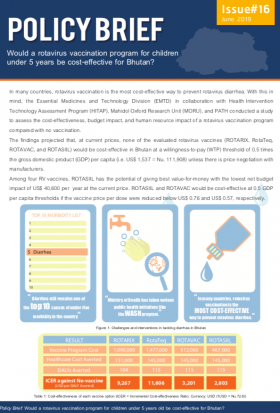This website uses cookies so that we can provide you with the best user experience possible. Cookie information is stored in your browser and performs functions such as recognising you when you return to our website and helping our team to understand which sections of the website you find most interesting and useful.
Policy Brief (Issue 16): Would a rotavirus vaccination program for children under 5 years be cost-effective for Bhutan?

รายละเอียดเพิ่มเติม
In many countries, rotavirus vaccination is the most cost-effective way to prevent rotavirus diarrhea. With this in mind, the Essential Medicines and Technology Division (EMTD) in collaboration with Health Intervention Technology Assessment Program (HITAP), Mahidol Oxford Research Unit (MORU), and PATH conducted a study to assess the cost-effectiveness, budget impact, and human resource impact of a rotavirus vaccination program compared with no vaccination.
The findings projected that, at current prices, none of the evaluated rotavirus vaccines (ROTARIX, RotaTeq, ROTAVAC, and ROTASIIL) would be cost-effective in Bhutan at a willingness-to-pay (WTP) threshold of 0.5 times the gross domestic product (GDP) per capita (i.e. US$ 1,537 = Nu. 111,908) unless there is price negotiation with manufacturers.
Among four RV vaccines, ROTASIIL has the potential of giving best value-for-money with the lowest net budget impact of US$ 40,600 per year at the current price. ROTASIIL and ROTAVAC would be cost-effective at 0.5 GDP per capita thresholds if the vaccine price per dose were reduced below US$ 0.76 and US$ 0.57, respectively.




